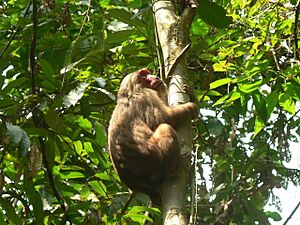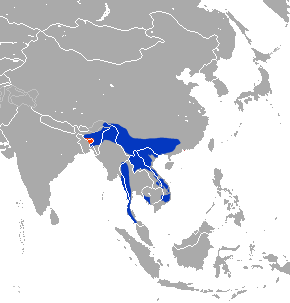Stump-tailed macaque facts for kids
Quick facts for kids Stump-tailed macaque |
|
|---|---|
 |
|
| Conservation status | |
| Scientific classification | |
| Genus: |
Macaca
|
| Species: |
arctoides
|
 |
|
| Stump-tailed macaque range (blue – native, red – introduced, orange – possibly extinct) |
|
| Synonyms | |
|
|
The stump-tailed macaque (Macaca arctoides), also called the bear macaque, is a type of monkey. It lives in parts of South Asia and Southeast Asia, including India, China, Thailand, and other countries. These macaques mostly eat fruit, but they also enjoy seeds, leaves, roots, and even small animals like freshwater crabs, frogs, bird eggs, and insects.
Contents
What Does a Stump-tailed Macaque Look Like?
Stump-tailed macaques have long, thick, dark brown fur covering most of their body. Their face and short tail are hairless. The tail is very short, only about 3 to 7 centimeters long.
When they are born, baby macaques are white. As they grow up, their fur gets darker. Their bright pink or red faces also turn darker, becoming brown or almost black.
Male macaques are bigger than females. Males are about 52 to 65 cm long and weigh around 9.7 to 10.2 kg. Females are about 48 to 58 cm long and weigh 7.5 to 9.1 kg.
Males have longer canine teeth. These teeth are important for showing who is in charge in their social groups. Like other macaques, they have special pouches in their cheeks. They use these pouches to store food for a short time.
Where Do Stump-tailed Macaques Live?
This Old World monkey usually walks on all four legs on the ground. They are not very good at climbing trees. They mostly live in evergreen tropical and subtropical moist broadleaf forests. They need these rainforests for food and shelter.
They can live in cold places because of their thick fur. They are found at high elevations, sometimes up to 4,000 meters in the Himalayas. Their home range stretches from northeastern India and southern China to parts of Malaysia. They also live in Burma, Thailand, Laos, Cambodia, and Vietnam. They might no longer live in Bangladesh.
In 1974, a group of stump-tailed macaques was brought to Tanaxpillo. This is an island in Lake Catemaco, Veracruz, Mexico. Most of what we know about these monkeys comes from studying this group and others in zoos. This is because it's hard to study them in the wild.
How Do Stump-tailed Macaques Behave?
Stump-tailed macaques live in social groups, much like other macaques. In their groups, females have a clear pecking order that usually stays the same. For males, their position in the group can change based on their fighting skills.
What makes these macaques special is how peaceful they are. They are very good at solving disagreements. Real fights rarely happen. Even small arguments are usually settled quickly. This is why they are known as a peaceful monkey species.
Stump-tailed macaques are not picky eaters. While fruit is a main part of their diet, they eat many other things. They have a strong, muscular body with thick limbs. This makes them good at moving on the ground but a bit clumsy in trees. They also eat more meat than other macaque species. They enjoy eating many insects, small animals, and eggs.
Reproduction
Stump-tailed macaques have two main times of the year when they mate. One season is in the summer, usually in July and August. The other season is in the fall, around November.
See also


